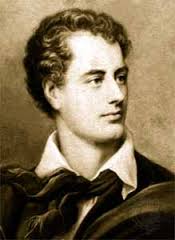
Forgery has always fascinated historians of literature, whether it takes the form of a whole manuscript or annotations in a printed book, or (of much rarer occurrence) a whole book or books, as in the case of Thomas Wise. The manuscript forgeries of the self-styled Major George Gordon De Luna Byron, alias De Gibler, alias Monsieur Memoir, were of some key Romantic poets, including Byron, Shelley and Keats. The one that concerns us here was a quatrain and a long prose note supposedly written by Lord Byron on the fly leaves of a copy of the fifth edition ( 1777) of the works of the eighteenth century poet, William Shenstone.
This particular forgery was well known to bibliophiles for many years, but had been long lost until our own Jot 101 CEO bought this particular copy in a book sale about eight years ago. Details were then handed on to Byron scholar Andrew Nicholson, who discussed them in a paper published in The Byron Journal in 2010. We at Jot 101 HQ are grateful to the late Mr Nicholson for his assiduous research which focuses on the nature of the forgery. It had been acquired by a certain Mr Young from the library sale in 1851 of John Wilks, MP, a well known collector of manuscripts.
The forgeries, penned in black ink, appeared in several volumes of the Works, as follows:
Volume 1: on the first fly-leaf at the head of the page
Trin. Coll. 1807
Byron
Beneath this inscription can be found, slanting upwards at 90 degrees from the bottom left hand corner of the page to the top right:
Reason for thick ancles
I cannot comprehend—says Dick-
What ‘tis that makes my legs so thick-
You do not comprehend -says Harry-
How great a calf they have to carry-
Volume II. On the first fly-leaf at the head of the page:
Trin. Coll. 1807
Byron
And on page 286, which is blank and faces the opening of ‘A Description of the Leasowes’ on page 287:
Leasowe—a common provincial term—is of Saxon origin—is often found in legal documents ---and was never before—perhaps—so classically applied as in this instance
Volume III. On the first fly leaf (recto) written at the head of the page:
Byron
Beneath which, sloping up the page and continuing on verso of the end fly-leaf ( slashes indicate breaks between recto and verso; double slashes breaks between first fly-leaf and end fly-leaf; angle brackets denote an erasure):
‘Shenstone died Febr. 11.1763. When a youngster I read Shenstone’s poems with eagerness & delight—their simplicity rendered them intelligent to my youthful capacity-and their beauty engaged my admiration-The talent-the energies-and the social character of Shenstone have never-I think-been fully scrutinized-nor faithfully appreciated. A popular –but anonymous novel of the day –under the title “Columella-or the distressed anchorite” held/him up by implication as a proper subject for banter and ridicule-with the idea of his being a peevish-discontented bachelor-instead of a rural gentleman-or a contemplative philosopher-And his <biography> redoubtable biographer Dr Johnson has-by the unsparing us of inuendo (sic) and surmise-tinged the mental portrait of the bard with his accustomed splenetic gloom-Surely no man was ever less qualified by natural disposition to sit in judgement on his contemporary—The contrast between them in taste and endowments was extreme—The // one an ardent admirer of the beautiful & uncloying simplicity of nature-the other as artificial a composition of dogmatism & prejudice as can well be imagined. It does not appear that Johnson was personally acquainted with him—or that he had ever seen his charming retreat-or if he had seen it-would it have possessed any charms for his singular mind-at once so capacious and so contrasted—Whether Gray was intimate with Shenstone does not appear—but the probability—at least-is that he knew him--.As to Shenstone’s powers as a poet-I agree with Johnson-that the School Mistress/is the most pleasing of his productions-and I think it quite sufficient to entitle him to a conspicuous niche in the Pantheon of the British Muses---Could Johnson himself have written it half so well? Could Burns have done it better?’
As Nicholson rightly remarks, the rather over elaborate and sententious style of these remarks, together with the un-Byronic two closing sentences, should have been a warning to anyone that the great Romantic poet could have had nothing whatsoever to do with them. Humour or wit, for which Byron was well known, is conspicuous by its absence, and the generally prosy character of the writing would surely have rung alarm bells. But the forger, for all his shortcomings as a writer, knew that at a time when autograph hunting was becoming fashionable, some collectors were willing to be convinced. And so it transpired. After the books had left the hands of Mr Young, who had wisely paid just £5 for them, they subsequently came into the possession of the writer Violet Fane, aka Lady Mary Currie (1843 – 1905), who was glad to acquire them, probably in the 1880s, for £20. In fact, she was in such a girlish swoon at the very notion that she now owned books in which the author of Don Juan had scribbled while a student at Cambridge that she penned some lines that betrayed her euphoria. These she subsequently included in her Poems (1892). History does nor relate whether Ms Currie ever discovered the truth about her spurious Byron manuscript. [R.M.Healey]
